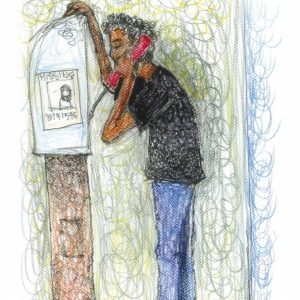
Story:
Imagine not knowing whether your child is alive. Perhaps you haven’t heard from them for months. Or maybe all you know is that they boarded a crowded boat days or weeks before. Then your phone rings, and a beloved voice says, “Hi, Mom—I’m alive!”
This story strains imagination for most of us. Yet, it’s not uncommon for the families of refugees making the perilous trip across the Mediterranean. If the young refugees are lucky enough to make it, the first thing they want to do is “call home.” In his book, Drawings from the Border, Francesco Piobbichi writes, “In Lampedusa, I have heard children say to their mothers, ‘Ciao mamma—sono vivo!’ their white-toothed smiles lighting up Lampedusa’s main street.”
Of course, the poster in Piobbichi’s drawing reminds us of the kids who didn’t make it. How many parents are still waiting, I wonder, for a call that will never come?
Bible Reading: Genesis 1:27 (NRSV)
So God created humankind in his image,
in the image of God he created them;
male and female he created them.
This verse is so familiar we may have become numb to it. But its message is shocking. It tells us that human beings are created in the image of God. Think about that. If we had any sense, we would break out the brass band, light some fireworks, or even better—fall to our knees.
In view of this verse’s claims, it would also make sense to think hard about turning away from tragedies that leave human beings dying along our world’s borders.
Paola La Rosa puts her finger on the pulse of this tragedy when she writes, “…whether we support the political left or the political right, whether we are religiously unbelieving or believing, whether we consider ourselves to be moral people or immoral people, in ways we may not be aware of, we continue to deny [the refugees’] personhood” (Drawings from the Border, p. vi).
No one has to remind the mother waiting for that phone call that her son is a person. But maybe we need a reminder. Maybe we need to be reminded that each of those people whose bodies litter the beaches and borders of this world were, in fact, created in the image of God.
Discussion/Reflection:
- How does the reminder that all are created in the image of God change or reinforce the way you think about refugees and migrants?
- What were your thoughts and feelings as you read the story, “Hello, Mom—I’m Alive!”?
Action:
- As you listen, watch, or read the news today, mentally insert the phrase “in the image of God” as people are named. Take note of how this affects your thoughts, words, and feelings.
- Make eye contact with a stranger you encounter today, remembering that they are created in the image of God. See if it makes a difference in how you regard them. Afterwards, talk about this experience with a friend.
Prayer: We fall to our knees, gracious God, when we remember both the honor and the responsibility of begin created in your image.
Welcoming the Stranger Series
In the last ten years more than 35,000 asylum seekers have died in the Mediterranean. Desperate to escape untenable situations in countries like, Syria, Eritrea, Sudan, and Somalia, refugees risk both life and livelihood to board rickety boats bound for what they hope will be a new life in Europe. Many of them die within sight of what they hoped would be the promised land.
Welcoming the Stranger is a devotional series designed to help Christians connect this unfolding humanitarian crisis in the Mediterranean with the Bible’s call to “welcome the stranger.” Recognizing that “the stranger” can sometimes be an abstraction that blinds us to the face of Christ, the series approaches the refugee crisis from a personal perspective. Each entry focuses on one person’s story, brought vividly to life by Italian artist and relief worker, Francesco Piobbichi. These stories are then linked to relevant Scripture, prayer, discussion, and action prompts.
Immigration is a hot topic around the globe, and the Bible passages in this series speak to wherever we are called to “welcome the stranger.” My specific interest in the Mediterranean context was sparked by a 2016 trip to the island of Lampedusa—a small island off the coast of Sicily that is the scene of so much hope and tragedy for refugees trying to enter Europe via small, unsafe boats. In addition learning about the situation there and the work being done by ecumenical groups like Mediterranean Hope, I spent significant time interviewing Francesco Piobbichi, whose art documents the stories of individual refugees and families who often die trying to reach safety. You can learn more about him and work through the following link: Francesco Piobbichi’s Artwork Each of his “snapshots” tells a story—sometimes of triumph, but often of tragedy: Piobbichi’s goal is to help people understand this large-scale human tragedy on a more personal level. My goal in this series is to use Piobbichi’s art as a starting point for Bible study and personal reflection/action.
